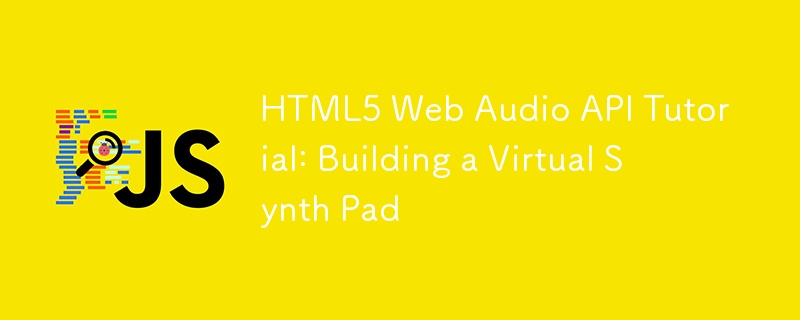HTML5 Web Audio API Tutorial: Building a Virtual Synth Pad
Feb 21, 2025 am 09:15 AMThis article explores the HTML5 Web Audio API, demonstrating how to build a basic virtual synth pad with various audio effects. We'll cover creating an AudioContext, loading and playing audio files, adding volume control, looping, reverb, and filters. While jQuery simplifies DOM manipulation, it's not strictly necessary for the Web Audio API itself.

Key Concepts:
- The Web Audio API enables sophisticated audio processing within web applications, ideal for creating virtual instruments and interactive audio experiences.
- The
AudioContextmanages audio nodes, providing a structured environment for loading, decoding, and manipulating audio data. - This tutorial builds a simple synth pad, illustrating core techniques like audio context creation, file loading and playback, and the implementation of effects such as volume control, looping, reverb (using
ConvolverNode), and filtering (BiquadFilterNode).
Building the Synth Pad:
The HTML structure uses four divs representing the synth pads, each linked to a sound file via a data-sound attribute. jQuery is used for easier DOM manipulation. A separate JavaScript file handles the Web Audio API interactions.
<div id="sp"> <div id="pad1" data-sound="kick.wav"></div> <div id="pad2" data-sound="snare.wav"></div> <div id="pad3" data-sound="tin.wav"></div> <div id="pad4" data-sound="hat.wav"></div> </div>
Audio Context and File Loading:
An AudioContext is created, and a loadAudio function handles asynchronous loading and decoding of audio files using XMLHttpRequest and decodeAudioData.
var context = new AudioContext();
function loadAudio(object, url) {
var request = new XMLHttpRequest();
request.open('GET', url, true);
request.responseType = 'arraybuffer';
request.onload = function() {
context.decodeAudioData(request.response, function(buffer) {
object.buffer = buffer;
});
};
request.send();
}
Playing Sounds and Adding Controls:
The addAudioProperties function enhances each pad div with properties for sound source, volume control (GainNode), and a play method. Event listeners trigger sound playback on clicks. Volume control is implemented using range inputs.
function addAudioProperties(object) {
// ... (code to add properties and play method) ...
}
$(function() {
$('#sp div').each(function() {
addAudioProperties(this);
});
$('#sp div').click(function() {
this.play();
});
// ... (code for volume control) ...
});
Looping, Reverb, and Filtering:
Looping is added using a loop button and modifying the AudioBufferSourceNode's loop property. Reverb is implemented using a ConvolverNode and an impulse response file. A lowpass biquad filter (BiquadFilterNode) allows for frequency and quality adjustments.
Conclusion:
This tutorial provides a practical introduction to the Web Audio API. The complete code, including HTML, CSS, and JavaScript, allows you to create a functional virtual synth pad, demonstrating key concepts and techniques for building interactive audio applications. Remember that this is a simplified example; the Web Audio API offers much more extensive capabilities for creating complex and sophisticated audio experiences.
The above is the detailed content of HTML5 Web Audio API Tutorial: Building a Virtual Synth Pad. For more information, please follow other related articles on the PHP Chinese website!

Hot AI Tools

Undress AI Tool
Undress images for free

Undresser.AI Undress
AI-powered app for creating realistic nude photos

AI Clothes Remover
Online AI tool for removing clothes from photos.

Clothoff.io
AI clothes remover

Video Face Swap
Swap faces in any video effortlessly with our completely free AI face swap tool!

Hot Article

Hot Tools

Notepad++7.3.1
Easy-to-use and free code editor

SublimeText3 Chinese version
Chinese version, very easy to use

Zend Studio 13.0.1
Powerful PHP integrated development environment

Dreamweaver CS6
Visual web development tools

SublimeText3 Mac version
God-level code editing software (SublimeText3)

Hot Topics
 Java vs. JavaScript: Clearing Up the Confusion
Jun 20, 2025 am 12:27 AM
Java vs. JavaScript: Clearing Up the Confusion
Jun 20, 2025 am 12:27 AM
Java and JavaScript are different programming languages, each suitable for different application scenarios. Java is used for large enterprise and mobile application development, while JavaScript is mainly used for web page development.
 Mastering JavaScript Comments: A Comprehensive Guide
Jun 14, 2025 am 12:11 AM
Mastering JavaScript Comments: A Comprehensive Guide
Jun 14, 2025 am 12:11 AM
CommentsarecrucialinJavaScriptformaintainingclarityandfosteringcollaboration.1)Theyhelpindebugging,onboarding,andunderstandingcodeevolution.2)Usesingle-linecommentsforquickexplanationsandmulti-linecommentsfordetaileddescriptions.3)Bestpracticesinclud
 Javascript Comments: short explanation
Jun 19, 2025 am 12:40 AM
Javascript Comments: short explanation
Jun 19, 2025 am 12:40 AM
JavaScriptcommentsareessentialformaintaining,reading,andguidingcodeexecution.1)Single-linecommentsareusedforquickexplanations.2)Multi-linecommentsexplaincomplexlogicorprovidedetaileddocumentation.3)Inlinecommentsclarifyspecificpartsofcode.Bestpractic
 How to work with dates and times in js?
Jul 01, 2025 am 01:27 AM
How to work with dates and times in js?
Jul 01, 2025 am 01:27 AM
The following points should be noted when processing dates and time in JavaScript: 1. There are many ways to create Date objects. It is recommended to use ISO format strings to ensure compatibility; 2. Get and set time information can be obtained and set methods, and note that the month starts from 0; 3. Manually formatting dates requires strings, and third-party libraries can also be used; 4. It is recommended to use libraries that support time zones, such as Luxon. Mastering these key points can effectively avoid common mistakes.
 JavaScript vs. Java: A Comprehensive Comparison for Developers
Jun 20, 2025 am 12:21 AM
JavaScript vs. Java: A Comprehensive Comparison for Developers
Jun 20, 2025 am 12:21 AM
JavaScriptispreferredforwebdevelopment,whileJavaisbetterforlarge-scalebackendsystemsandAndroidapps.1)JavaScriptexcelsincreatinginteractivewebexperienceswithitsdynamicnatureandDOMmanipulation.2)Javaoffersstrongtypingandobject-orientedfeatures,idealfor
 Why should you place tags at the bottom of the ?
Jul 02, 2025 am 01:22 AM
Why should you place tags at the bottom of the ?
Jul 02, 2025 am 01:22 AM
PlacingtagsatthebottomofablogpostorwebpageservespracticalpurposesforSEO,userexperience,anddesign.1.IthelpswithSEObyallowingsearchenginestoaccesskeyword-relevanttagswithoutclutteringthemaincontent.2.Itimprovesuserexperiencebykeepingthefocusonthearticl
 JavaScript: Exploring Data Types for Efficient Coding
Jun 20, 2025 am 12:46 AM
JavaScript: Exploring Data Types for Efficient Coding
Jun 20, 2025 am 12:46 AM
JavaScripthassevenfundamentaldatatypes:number,string,boolean,undefined,null,object,andsymbol.1)Numbersuseadouble-precisionformat,usefulforwidevaluerangesbutbecautiouswithfloating-pointarithmetic.2)Stringsareimmutable,useefficientconcatenationmethodsf
 What's the Difference Between Java and JavaScript?
Jun 17, 2025 am 09:17 AM
What's the Difference Between Java and JavaScript?
Jun 17, 2025 am 09:17 AM
Java and JavaScript are different programming languages. 1.Java is a statically typed and compiled language, suitable for enterprise applications and large systems. 2. JavaScript is a dynamic type and interpreted language, mainly used for web interaction and front-end development.






